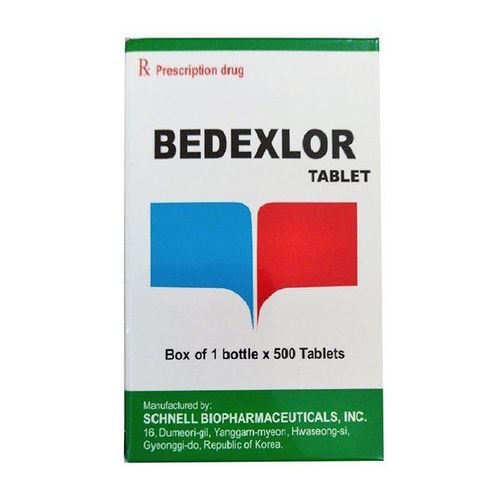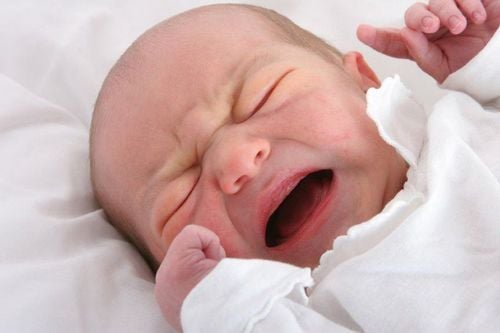This is an automatically translated article.
The article is professionally consulted by Master, Doctor Phan Thi Cam Van - Neonatologist - Pediatrics - Neonatology - Vinmec Danang International General HospitalPneumothorax is a common condition in children, especially those born prematurely, aspirated meconium, or children who received respiratory support at birth. The treatment of pneumothorax in an infant depends on the severity of the symptoms.
1. What is neonatal pneumothorax?
Pneumothorax is a syndrome that occurs when air enters the pleural space but cannot exit, causing the lung parenchyma to collapse toward the hilum. Pneumothorax can be caused by air entering from outside the body or by air entering the chest from the lungs. Most cases of pneumothorax occur when air from the lungs leaks out into the pleura. Air from the lungs into the chest is because the alveoli (small air sacs in the lungs where oxygen and CO2 are exchanged) burst, causing air to escape, into the pleural space causing pneumothorax.
Neonatal pneumothorax can be mild or severe depending on the amount of air trapped. This is a dangerous disease that can cause sudden respiratory failure and, if not treated promptly, can easily lead to death.
Symptoms of pneumothorax in infants include:
Shortness of breath, rapid breathing; Pale, tired skin; Fast heart beat
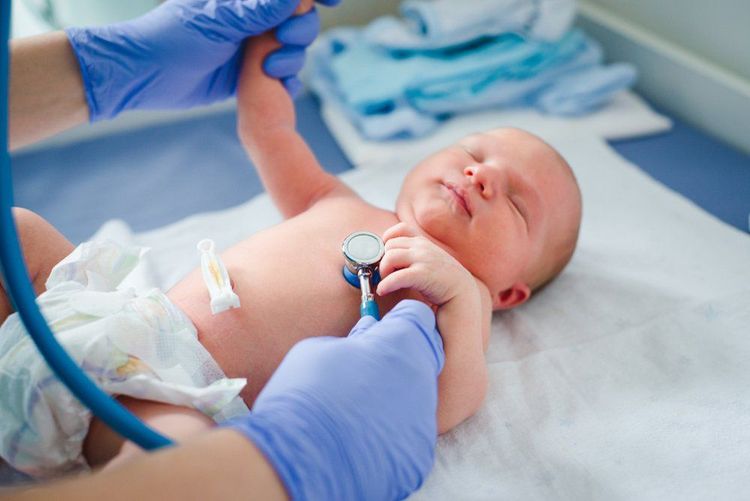
Trẻ sơ sinh ngất xiu do khí màng phổi
2. Causes of pneumothorax in newborns
Newborn's lungs are very immature and prone to pneumothorax due to enlarged lungs after birth. Factors that increase the risk of pneumothorax in infants include:
Premature birth: Newborns have fragile lung tissue, alveoli are more fragile than other age groups. Babies born with a birth weight of less than 1.5 kg have a higher risk of pneumothorax; Inhaling meconium: Meconium can clog an infant's airways, preventing air from entering but not leaving the lungs. The large amount of air increases the pressure, causing the alveoli to burst and causing pneumothorax in the newborn; Requires respiratory support at birth: In cases where the baby is not breathing after birth, medical staff will use an ambu ball or other device to support breathing until the baby begins to breathe on his own. Respiratory support can cause pneumothorax; Mechanically ventilated: Children receiving respiratory support from a ventilator or CPAP are at high risk for pneumothorax because the ventilator pushes air into the lungs to help inflate the lungs, increasing the amount of oxygen the child can absorb.
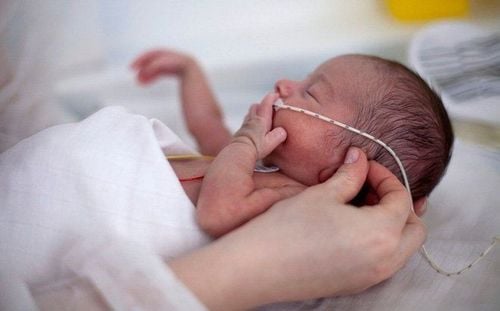
Trẻ sinh non có thể gây tràn khí màng phổi
3. Treatment of pneumothorax in infants
When the infant is suspected of having a pneumothorax, the doctor will ask the parents about the medical history, physical examination, and chest X-ray to confirm the diagnosis. In addition, your doctor may perform other diagnostic tests for pneumothorax, such as checking blood oxygen levels and examining your heart with an electrocardiogram.
Once it is determined that the infant has a pneumothorax, the doctor will prescribe the appropriate treatment. Treatment depends on the severity of your symptoms and the amount of gas that is leaking. Children with mild pneumothorax, who may have no symptoms, do not need treatment because the body can reabsorb the air. For children with a lot of pneumothorax, it can be difficult to breathe, even pushing the heart, trachea or large vessels out of place, which can be life-threatening.
In case of severe pneumothorax, the principles of treatment include: Emergency treatment, treatment of pneumothorax and treatment of the underlying cause. Specifically:
3.1 Emergency treatment
Treatment of respiratory failure; Perform emergency pneumothorax in neonates with respiratory distress associated with large amounts of air or suspected tension pneumothorax; 3.2 Treatment of pneumothorax
Supplemental oxygen: In some cases, giving a child 100% breathing can help the child's body reabsorb air from the pneumothorax; Pneumothorax: Choose aspiration alone (for cases of small pneumothorax, the patient does not have difficulty breathing) or aspiration with drainage (aspiration to probe first for all cases requiring drainage) . The technique is to insert a needle attached to the syringe through the chest wall to drain the air that has accumulated in the pleural space. The needle is then withdrawn and the skin covered; Intubation: In case of spontaneous pneumothorax with a small amount, the child does not have difficulty breathing, it is necessary to monitor, take X-ray after 6 hours and if the amount of air is increased, aspirate and place a drainage tube. . Other cases of pneumothorax or increased pneumothorax, recurrent pneumothorax, severe pneumothorax, and pneumothorax in mechanically ventilated preterm infants require aspiration and drainage. This technique uses a small plastic tube inserted through the chest and fixed and then connected to a suction machine. The suction machine removes the air that has accumulated in the pleural space. After the air is withdrawn, the chest tube is removed, and the fistula heals. After treating a pneumothorax in an infant, your doctor will take a chest X-ray to make sure the fistula has healed and that no air has accumulated in the pleural space.
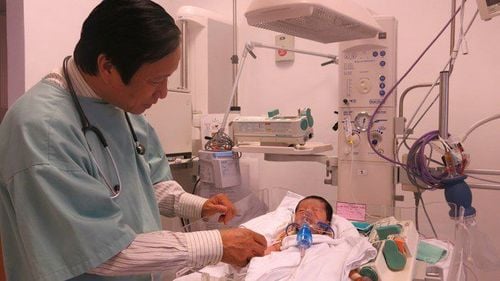
Trẻ được thở máy và đặt ống dẫn lưu
3.3 Treat the cause Remove the foreign body in the airway; Treatment of asthma, pneumonia, tuberculosis according to the standard regimen. Consider surgical intervention if the above treatments fail, the pneumothorax persists, recurs, or the patient is at high risk of recurrence (persistent air loss, incomplete lung expansion after treatment). , large pulmonary cyst, recurrent pneumothorax on the same side as the first). Surgical measures include: Laparoscopic surgery or thoracotomy to seal the fistula, lobectomy with air cysts.
After treatment, parents need to monitor the child continuously, re-examination 24 - 48 hours after discharge from the hospital. After that, it is necessary for the child to have a follow-up visit once a week for the first month to monitor the baby's health status.
Pediatrics department at Vinmec International General Hospital is the address chosen by many parents to examine and treat common diseases in children such as: otitis media, bacterial fever, viral fever, pneumonia. in children, .... With modern equipment, sterile space, minimizing the impact as well as the risk of disease spread, a team of leading specialists, experienced professionals will help. Examination is no longer a concern of parents.
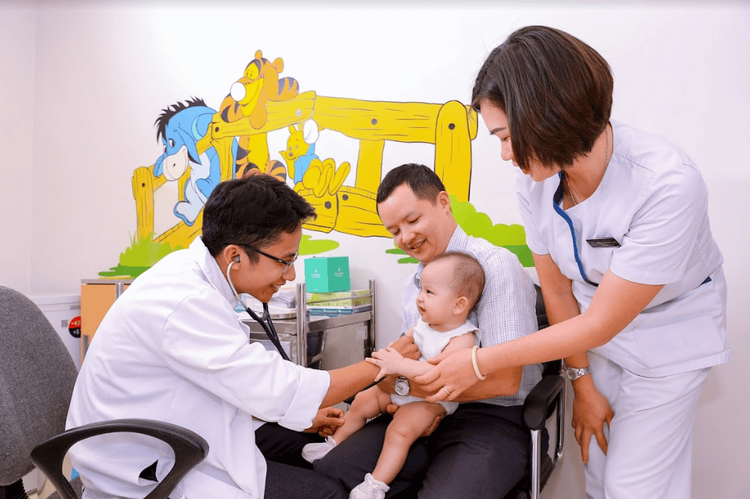
Khám nhi tại Bệnh viện Đa khoa Quốc tế Vinmec
To register for examination and treatment at Vinmec International General Hospital, you can contact Vinmec Health System nationwide, or register online HERE.
MORE
Causes and diagnosis of pneumothorax Intubation of a pleural tube in respiratory patients Possible complications of pneumothorax




